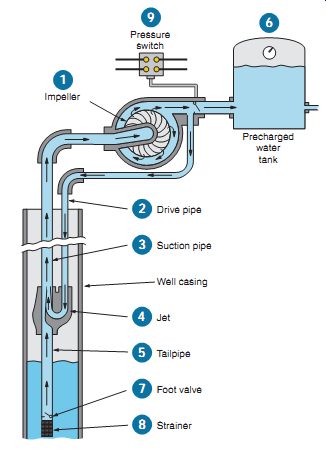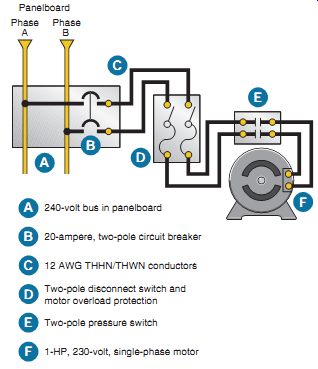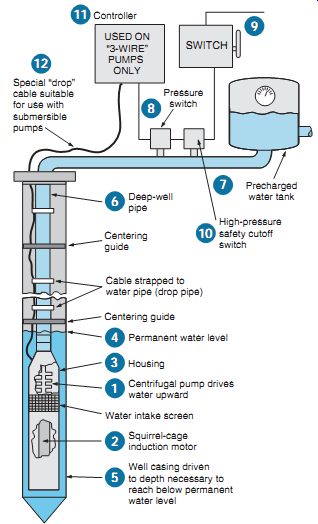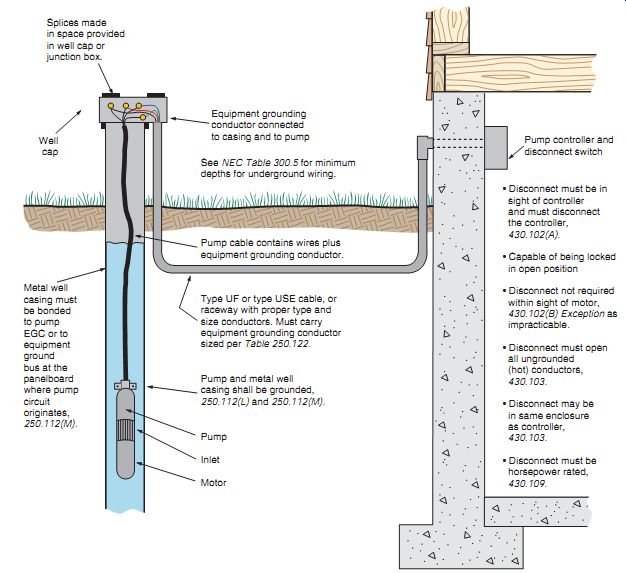.
LEARNING GOALS:
• understand the operation of jet pumps, submersible pumps, and their components.
• understand the operation of electric water heaters and their components.
• be familiar with the NEC requirements for designing the branch circuit, including conductors, cables, raceway, motor branch-circuit short-circuit ground-fault and overload protection, disconnecting means, and grounding for water pumps and electric water heaters.
• figure out various electrical connections for "Time-of Use" metering.
• calculate the effect of voltage variation on heating elements and motors.
• understand the hazards of possible scalding.
• discuss heat pump water heaters.
Part 1 | Part 2 | Part 3 | Part 4 | part 5 | Part 6
WATER PUMP CIRCUIT
In rural areas where there is no public water sup ply, dwellings need their own water supply. The Electrical Plans and Schedule of Special Purpose Outlets for this residence show that the well pump is connected to Circuit A 5-7.
After a brief introduction to jet pumps and submersible pumps, we will discuss the key elements that make up a typical motor branch circuit.
For the most part, submersible pumps dominate the residential market.
The manufacturer's installation instructions must always be followed.
===

Above: FGR. 1 Components of a jet pump.
Precharged water tank; Pressure switch; Impeller Drive pipe; Suction pipe; Well casing Jet; Tailpipe; Foot valve; Strainer.
===

Above: FGR. 2 The pump circuit.
1-HP, 230-volt, single-phase motor, Two-pole pressure switch, Two-pole disconnect switch and motor overload protection; 12 AWG THHN/THWN conductors; 20-ampere, two-pole circuit breaker; 240-volt bus in panelboard. Phase/ Phase; Panelboard
===
JET PUMPS
FGR. 1 shows the major components of a typical deep-well jet pump.
The pump impeller wheel, 1, forces water down a drive pipe, 2, at a high velocity and pressure to a point just above the water level in the well casing. Just above the water level, the drive pipe curves sharply upward and enters a larger vertical suction pipe, 3. The drive pipe terminates in a small nozzle or "jet," 4. The water emerges from the jet with great force and flows upward though the suction pipe.
Water rises in the suction pipe, drawn up through the tailpipe, 5, by the action of the jet. The water rises to the pump inlet and passes through the impeller wheel of the pump. Some of the water is forced down through the drive pipe again. The remaining water passes through a check valve and enters the storage tank, 6.
The foot valve, 7, prevents water in the pumping equipment from draining back into the well when the pump is not operating. The strainer, 8, keeps debris out of the system. The pressure switch, 9, starts and stops the pump motor.
FGR. 2 shows the wiring of a typical water pump. Always follow the wiring instructions furnished by the specific pump manufacturer.
SUBMERSIBLE PUMPS
FGR. 3 shows the major components of a typical submersible pump.
===
Controller SWITCH Pressure switch Special ‘drop’ cable suitable for use with submersible pumps USED ON ‘3-WIRE’ PUMPS ONLY Precharged water tank High-pressure safety cutoff switch Deep-well pipe Centering guide Cable strapped to water pipe (drop pipe) Centering guide Permanent water level Centrifugal pump drives water upward Water intake screen Squirrel-cage induction motor Well casing driven to depth necessary to reach below permanent water level Housing

Above: FGR. 3 Submersible pump.
=== A submersible pump consists of a centrifugal pump, 1, driven by an electric motor, 2. The pump and the motor are contained in one housing, 3, submersed below the permanent water level, 4, within the well casing, 5. The pump housing is a cylinder 3-5 in. in diameter and 2-4 ft long. When running, the pump raises the water upward through the piping, 6, to the water tank, 7. Proper pressure is maintained in the system by a pressure switch, 8. The disconnect switch, 9, pressure switch, 8, limit switches, 10, and controller,11, are installed in a logical and convenient location near the water tank.
Pumps commonly called "2-wire pumps" contain all required starting and protection components and connect directly to the pressure switch-with no other aboveground controller. Generally, there are no moving electrical parts within the submersible pump, such as the centrifugal starting switch found in a typical single-phase, split-phase induction motor.
Other pumps, referred to as "3-wire pumps," require an aboveground controller that contains any required components not in the motor, such as a starting relay, overload protection, starting and running capacitors, lightning arrester, and terminals for making the necessary electrical connections.
Most water pressure tanks have a precharged air chamber in an elastic bag (bladder) that separates the air from the water. This ensures that air is not absorbed by the water. Water pressure tanks com press air to maintain delivery pressure in a usable range without cycling the pump at too fast a rate.
When in direct contact with the water, air is gradually absorbed into the water, and the cycling rate of the pump will become too rapid for good pump life unless the air is periodically replaced. With the elastic bag, the initial air charge is always maintained, so recharging is unnecessary.
Submersible pumps are covered by UL Standard 778.
Submersible Pump Cable
Power to the motor is supplied by a "drop" cable especially designed for use with submersible pumps. This cable is marked "submersible pump cable," and it’s generally supplied with the pump.
This cable can also be purchased separately. The cable is cut to the proper length to reach between the pump and its controller, as shown in FGR. 3, or between the pump and the well cap, FGR. 4.
When needed, the cable may be spliced according to the manufacturer's specifications.
Submersible water pump cable is "tag-marked" for use within the well casing for wiring deep-well water pumps, where the cable is not subject to repetitive handling caused by frequent servicing of the pump units.
A submersible pump cable is not designed for direct burial in the ground unless it’s marked "Type USE" or "Type UF." Should it be required to run the pump's circuit underground for any distance, it’s necessary to install Type UF or Type USE cable or a raceway with suitable conductors, and then make up the necessary splices in a listed weatherproof junction box, as in FGR. 4. Section 16 covers underground wiring in great detail.
===
Grounding and disconnecting means requirements for submersible water pumps.
Splices made in space provided in well cap or junction box.
Equipment grounding conductor connected to casing and to pump; Pump cable contains wires plus equipment grounding conductor.
See NEC Table 300.5 for minimum depths for underground wiring.
Pump controller and disconnect switch:
- Disconnect must be in sight of controller and must disconnect the controller, 430.102(A).
- Capable of being locked in open position
- Disconnect not required within sight of motor, 430.102(B) Exception as impracticable.
- Disconnect must open all ungrounded (hot) conductors, 430.103.
- Disconnect may be in same enclosure as controller, 430.103.
- Disconnect must be horsepower rated, 430.109.
Type UF or type USE cable, or raceway with proper type and size conductors. Must carry equipment grounding conductor sized per Table 250.122.
Pump and metal well casing shall be grounded, 250.112(L) and 250.112(M). Pump Inlet Motor Well cap Metal well casing must be bonded to pump EGC or to equipment ground bus at the panelboard where pump circuit originates, 250.112(M).
